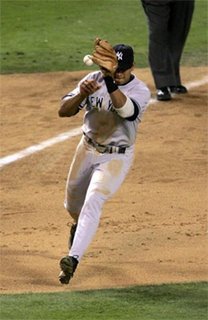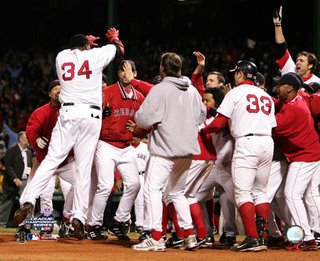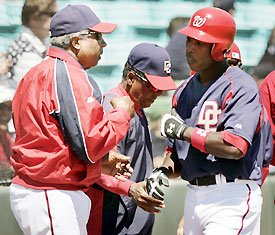All you have is the data available and some gut instinct. Plus, it helps immeasurably to know which data to look at. For instance, last year's actual win totals are pretty much meaningless when it comes to predicting the upcoming season. If I mention them at all in the upcoming paragraphs, it won't be frequent and it won't be because I feel they are a hallmark of future performance.
AL EAST
Here are the 2005 Pythagorean records of each team:
W | L | |
| Yankees | 90 | 72 |
| Red Sox | 90 | 72 |
| Blue Jays | 88 | 74 |
| Orioles | 74 | 88 |
| Devil Rays | 65 | 97 |
These totals are based upon the runs scored and allowed by each team, respectively, and they are generally considered a much better indicator of a team's true quality. Note that both the Sox and Yankees dropped five wins. Had the four AL playoff spots been based upon Pythagorean winning percentage only, both clubs would have missed the post-season last year. Also note how close the Blue Jays were. These teams are not quite the dynamic duo they have been in past years. In reality, Toronto was a closer team than anyone thought, and the AL East as a whole wasn't that good last year. Now that we know the off-season changes made by each team, we can use last year's projections as a base and start to project ahead.
 I think the Yankees got a bit better offensively with the addition of Johnny Damon, but they treaded water on their pitching staff and collectively got a year older. They got essentially healthy years from Jeter, Matsui, A-Rod, Sheffield, Giambi and Posada, a bunch of aging regulars who simply can't be expected to repeat that performance. I suspect they'll score a bit more than last year, but not by nearly the amount some people are expecting.
I think the Yankees got a bit better offensively with the addition of Johnny Damon, but they treaded water on their pitching staff and collectively got a year older. They got essentially healthy years from Jeter, Matsui, A-Rod, Sheffield, Giambi and Posada, a bunch of aging regulars who simply can't be expected to repeat that performance. I suspect they'll score a bit more than last year, but not by nearly the amount some people are expecting.
At the same time, my guess is that their pitching will regress. Randy Johnson and Mike Mussina are each a year older and fragile, while Jaret Wright, Carl Pavano and Chien-Ming Wang each missed time through injury last year. To Wang may become a good, reliable pitcher, but to expect Wright or Pavano to return to form, or to expect Johnson and Mussina to replicate their combined.400+ innings, 30 wins and 4.06 ERA, would be foolish. It would be similarly foolish to expect Kyle Farnsworth to post the kind of number Tom Gordon regularly provided, and one of these days, 36-year old Mariano Rivera's single pitch will lose one or two miles an hour and he'll become pretty ordinary.
Now, many, perhaps even most, of these things won't happen this year. But some will, and the Yankees system-wide lack of major league-ready depth is going to take its toll eventually. I'm guessing that will happen this year. They'll still be good, probably in the area of 90 wins, as they projected last year, but that total makes them more likely to miss the playoffs than make them.
Meanwhile, the rival Red Sox are in a slightly different boat. They are aging in in many areas just as badly as the Yankees, with the key difference that Boston's front office has stockpiled a lot of talent in the high minors that could contribute this year, either directly or through trades that bring in reliable veterans. Plus, they have built in flexible, young depth at the key questionable roster spots. Mike Lowell coming off a poor year? No problem, we've got Kevin Youkilis to slide over to third base if needed. J.T. Snow showing his age this spring? That's okay, Hee-Seop Choi is sitting in Pawtucket waiting for some playing time. Trot Nixon's knees giving out? There stands Wily Mo Pena or Adam Stern. A starter finally feeling his age? Enter Jonathan Papelbon or Jon Lester. On top of that, the club got younger in center field, and third base, and shortstop and first base, as well as a key rotation slot with the addition of Josh Beckett, a proven Yankee-killer. Their entire bench got younger except for Snow, and while the pitching staff collectively got older, that is also the area where the club has the most talent in the minors ready to contribute.
Toronto's case is a hard one. The numbers tells me they were a better team than their record showed last year, and I know they added some nice pieces in the off-season. But their top two starters are injury prone, and they gave up their vacuum cleaner second baseman who was so key to that staff's success. I don't think they'll regress at all, but I don't see them passing either of the two traditional powers.
Baltimore will be better simply by virtue of having their luck change. After the Rafael Palmeiro debacle last year, the parts started falling off the Oriole bandwagon faster than they fell of Apollo 13. Then Brian Roberts suffered his ugly elbow injury and the team dropped like a rock. They should be better this year, and their young arms look pretty promising, but I doubt they'll reach .500.
Tampa? They still play baseball there? No, to be serious, the Devil Rays will hit this year, but their pitching is a joke and their new front office didn't make any serious moves with their wealth of outfielders to acquire help for the rotation or bullpen. I guess I'm just don't know what direction this team is going, but I know it won;t be up in the standings.
Predicted Finishes:
W | L | |
| Red Sox | 94 | 68 |
| Yankees | 90 | 72 |
| Blue Jays | 86 | 76 |
| Orioles | 77 | 85 |
| Devil Rays | 70 | 92 |
AL CENTRAL
2005 Pythagorean Standings:
W | L | |
| Indians | 96 | 66 |
| White Sox | 91 | 71 |
| Twins | 84 | 78 |
| Tigers | 75 | 87 |
| Royals | 60 | 102 |
 It shouldn't shock anyone that the White Sox were playing way over their heads last year. Their offense was subpar, as they posted the lowest percentage in the entire league of team plate appearances by players with above-average on-base percentages. Almost 60% of the team's plate appearances wee by someone who doesn't reach base at least at a league-average level. The team OBP was just .322, 12th in the AL. That's bad, because OBP is one of the primary building blocks of offense, along with power. Thankfully for the Sox, they had plenty of that, muscling up for 200 team homers. They'll need to do that again, because no one besides Jim Thome was brought in to help the situation, and he's got a chronically bad back. Couple that with a regression to normal performance levels for some of their pitchers, especially in the bullpen, plus a normal leveling out of luck on the injury front, and I think Chicago is due for a fall.
It shouldn't shock anyone that the White Sox were playing way over their heads last year. Their offense was subpar, as they posted the lowest percentage in the entire league of team plate appearances by players with above-average on-base percentages. Almost 60% of the team's plate appearances wee by someone who doesn't reach base at least at a league-average level. The team OBP was just .322, 12th in the AL. That's bad, because OBP is one of the primary building blocks of offense, along with power. Thankfully for the Sox, they had plenty of that, muscling up for 200 team homers. They'll need to do that again, because no one besides Jim Thome was brought in to help the situation, and he's got a chronically bad back. Couple that with a regression to normal performance levels for some of their pitchers, especially in the bullpen, plus a normal leveling out of luck on the injury front, and I think Chicago is due for a fall.
The Indians, as last season's projections indicate, were the class of the division. They're a bit weaker offensively, but can still expect some development from their stars because none of them are terribly old. Plus, they have several solid hitters in Triple A, just waiting for someone to falter. The solid bullpen should return and backstop a rotation that will be no worse for the losses of Kevin Millwood and Scott Elarton.
Detroit will be much better, with young arms coming out of their ears and a new manager who knows which buttons to push. Plus, they don't really have a lineup weakness, though no one stands out as a star either. I think Leyland will push this club to the .500 level or better.
Minnesota, on the other hand, continues to do nothing in the off-season to impress me. Knowing they have glaring offensive weaknesses, the Twins decided to do nothing but sign Luis Castillo to play second base and Rondell White to DH, while praying that Torii Hunter is healthy and Justin Morneau and Joe Mauer finally cash in on their promise. That's a shaky plan at best. I think they'll pitch their way to contention, meaning they'll linger at .500 or a few games above, but I just don't think they've got the sticks.
Which brings me to my Royals. Only Chicago was worse at sending good on-base men to the plate last year, and the Royals tried to address that with three guys who traditionally reach base at a decent rate, Mark Grudzielanek, Reggie Sanders, and Doug Mientkiewicz. That will help, as will healthy season from David DeJesus and Mike Sweeney, and continued development from John Buck and Mark Teahen. I won't be shocked at all if the Royals approach league average levels of offense. I don't expect it, but it wouldn't be a shock.
The pitching, on the other hand, is still highly questionable. And I mean that literally. Can Scott Elarton be league-average again? Can Joe Mays return to his pre-injury form? Is Jeremy Affeldt really a starter? Can Denny Bautista cash in on his talent? Will Zack Greinke find his way? Will Runelvys Hernandez find a lock for his refrigerator? Will Scott Redman's knees hold up? Or Mike MacDougal's shoulder? It's a really sad state of affairs when the least question marks on the entire staff are in regard to the long man out of your bullpen, Mike Wood, who is pretty much a known quantity at this point, and a mediocre one at that.
All in all, I think the Royals will be better. But since they're now in a division where all four other teams will likely be at or above .500, "better" means it will still be a struggle to avoid triple digits in the loss column.
Predicted Finishes:
W | L | |
| Indians | 95 | 67 |
| White Sox | 91 | 71 |
| Tigers | 85 | 77 |
| Twins | 84 | 78 |
| Royals | 63 | 99 |
AL WEST
2005 Pythagorean Standings:
W | L | |
| Angels | 93 | 69 |
| A's | 93 | 69 |
| Rangers | 82 | 80 |
| Mariners | 76 | 86 |
 Last season, the only thing keeping the A's from being just as good as the Angels was luck and inexperience. Statistically, the two clubs were of equal quality. The difference was that the Angels played a touch over their heads, due in large part to a solid bullpen that always helps win a one-run game or two that they otherwise shouldn't have won. At the same time, Oakland had some terrible luck, losing their best pitcher, Rich Harden, and player, Bobby Crosby, for extended periods. Plus, they were just very, very young, and experience counts to a degree when you're in crunch time.
Last season, the only thing keeping the A's from being just as good as the Angels was luck and inexperience. Statistically, the two clubs were of equal quality. The difference was that the Angels played a touch over their heads, due in large part to a solid bullpen that always helps win a one-run game or two that they otherwise shouldn't have won. At the same time, Oakland had some terrible luck, losing their best pitcher, Rich Harden, and player, Bobby Crosby, for extended periods. Plus, they were just very, very young, and experience counts to a degree when you're in crunch time.
This year, things have changed. The A's are now a year older, and picked up two solid veteran bats, Milton Bradley and Frank Thomas, plus a solid 200-inning fifth starter in Esteban Loaiza. They have their star player, Crosby, back healthy, as is Harden. At the same time, the Angels did little to improve other than clear space for some youngsters. I'm all in favor of that, particularly in the Angels' case because the people they let go really were blocking better young players, but it does have the effect of putting some inexperience on the field, the same situation the A's faced last year. In essence, it's a blend I don't like, since too many of the veterans who were kept are well overrated (Garret Anderson, Darin Erstad, Orlando Cabrera, Bartolo Colon), and generally have health questions, while the younger guys just don't have much time under their belts.
I like what the Rangers did this off-season in dumping Alfonso Soriano, not only because he was nearly useless when he wasn't hitting for power, but because they got the better everyday player, Brad Wilkerson, in return. Just watch as Wilkerson blossoms in Texas, assuming he can stay on the field. They also added some pitching, which was desperately needed. I just don't think they added enough given the two solid teams ahead of them.
Do I have to talk about the Mariners? Well, I guess they're still in the league, but the reality is that I don't see them making much noise. They're not bad, and have some fine players in Richie Sexson, Ichiro Suzuki (who I refuse to call by just one name), Adrian Beltre and pitching phenom Felix Hernandez. But they're going to be buried by the unbalanced schedule, having to play the other three clubs in their division so much. Plus, the American League is just so loaded with quality teams that the ones who struggle will probably struggle mightily. The Mariners qualify.
Projected Standings:
W | L | |
| A's | 97 | 65 |
| Angels | 89 | 73 |
| Rangers | 84 | 78 |
| Mariners | 72 | 90 |
Playoffs:
ALDS: Oakland over Chicago; Boston over Cleveland
ALCS: Boston over Oakland in a classic
 The two final teams are both playoff savvy to a large degree, and are balanced teams with good pitching and a solid offense. Plus, they don't really like each other from previous years of playoff showdowns. It has all the makings of a classic series, and it could go either way, but given the playoff experience of the Boston rotation and most of their lineup, I think they'll take the ALCS in seven games.
The two final teams are both playoff savvy to a large degree, and are balanced teams with good pitching and a solid offense. Plus, they don't really like each other from previous years of playoff showdowns. It has all the makings of a classic series, and it could go either way, but given the playoff experience of the Boston rotation and most of their lineup, I think they'll take the ALCS in seven games.
Yes, I'm speaking with my heart a bit on his one. But it's not like I'm picking the Royals.




